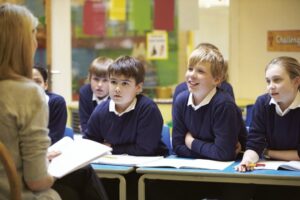The Orton Gillingham workbooks help those who have some difficulty reading, connecting every letter and every sound. Only a few years after meeting in education, this method incorporates into school reading programs; for having a delicately structured approach.
Certainly, breaking down the reading and spelling topics into simpler things that could relate to letters and sounds was a truly exceptional idea. Thus, this method was the pioneer in introducing the theme of “multisensory” to teach reading; being something of mandatory use in any literacy program.
Put another way, instructors use the senses, like touch, hearing, and movement to teach their students how to connect language. Therefore, this connection is made with letters and words; being today, a method widely used with students with dyslexia.
The learning method by Orton Gillingham
The creator of the learning method Orton Gillingham worked for Columbia University, Anna Gillingham was an education specialist and trained teacher. Samuel Orton was a well-known pathologist and psychiatrist highly respected; they studied children with learning difficulties. Gillingham thought to incorporate some ideas from Orton.
Thus, he created the training manuals, to finally publish what would be a standard of the Orton Gillingham method, a kind of recovery test for children. Then, the approach was aimed at children with disabilities in the area of reading, spelling, and calligraphy; and its first publication was in 1935.
There are countless books created from this first edition, with specific approaches.
Orton Gillingham workbooks for kids with dyslexia
Indeed, one of the Orton Gillingham workbooks is this book with 100 activities to improve writing and reading skills in children with dyslexia; Black and White Edition. A structured and multisensory approach to teaching reading used since 1935, demonstrated great benefits neurologically and linguistically, to students with difficulties in reading.
In fact, it is a model of frequent and successful reading intervention; with activities based on this methodology, which contain:
- Knowing letters
- Alphabetical order
- Sound identification
- Rhythmic words
- Visual words
- Homophones
Besides, it is a book that has been exhaustively reviewed by child psychologists; where you will get the necessary activities to improve your writing and reading skills.
Orton Gillingham workbooks and tools for kids with dyslexia
100 Orton Gillingham workbooks for children with dyslexia, which will differentiate and correctly use the letters “b”, “d”, “p”, and “q”, for children aged 6-8 years. Here learning to read and write represents a great challenge, both for families and educators.
For children with this disability, written language is a huge barrier, generating rejection of the task, frustration, and a lot of discomforts. This book contains activities to:
- Read and trace the letters “b”, “d”, “p” and “q”
- Write and color the letters “b”, “d”, “p” and “q”
- Seal and write
- Enclose the sound in a circle
- Find the missing sound
- Make a maze of letters “b”, “d”, “p” and “q”
The Orton Gillingham method is the ideal tool for educators because it has many resources that they can use to teach reading and writing. With instructions for children, especially with dyslexia; delicately structured, organized, and multisensory, with research on the teaching of phonetics.
Aimed at students with dyslexia where the instruction of explicit and systematic phonetics; through multisensory methods, is the most effective and can be applied to readers with difficulties.

Orton Gillingham workbooks for decodifiable readers
Undoubtedly, with Orton Gillingham practicing long and short vowels, work with decodable texts to help readers with reading difficulties. So, the content of this text has a focus to work only on the vowel “A”; designed to help children with the practice patterns.
Specifically focused on letters and sounds, demonstrated as part of a synthetic phonetics curriculum; and can be read backward. It is indifferent if it starts on the last page, from back to front; giving children an opportunity to discover a full spectrum of strategies.
After each reading, there are questions for the child so that his focus is not only on reading, but to understand and retain certain data. Reading is reflected with other activities to break the monotony in a fun and challenging way for the child; such as:
- To identify the name of a certain image
- To pray with a given word
- Finding certain words in an alphabet soup and crosswords
In this book you can find texts to work on:
- Short “A”, long “A” (words ai), long “A” (ay words), long “A” (ea words), long “A” (ei words), long “A” (words a_e), long and short words with ‘A’.
- Miscellaneous Resources
Decodable readers (1)
Practicable with long and short vowels, with decodable texts to help readers with difficulties, to improve their reading skills. The content of this book designed with Orton Gillingham to work alone the vowel “I” where the “decodable readers” will help children.
With a focus on the practice of a specific pattern of letters and sounds displayed as part of a synthetic phonetics curriculum. You can start reading on the first or last page, or backward, it offers children the opportunity to look at many strategies.
This book includes texts so that the student can read and at the same time identify some words within the text. You will also find questions at the end, so that the child does not entertain himself with reading alone, but dares to understand and retain information from the text.
In addition, the book works in the area of reinforcements, incorporating other activities to break with repetitive schemes, making it fun and challenging for the reader, with these resources:
- To Identify the name of an image
- Making sentences with a word
- To find some words in an alphabet soup and crosswords
In this book we work with the letter “I”:
- “I” abbreviated
- “I’ long (words with i)
- Long “I” (high words), long “I” (words and), long “I” (i.e. words)
- Wide “I” (words i-e)
- Activities with words with the long “I”
- Miscellaneous Resources
Decodable readers (2)
They practice long and short vowels with Orton Gillingham, to help struggling readers improve their reading skills. The content of this book focuses on working only on the “O” vowel, designed to help children in the practice of patterns.
It is specifically focused on letters and sounds that are part of a structured program of synthetic phonetics, which can be read from the last page or backward. A book to discover a spectrum of strategies that help to understand any book, reading and identifying certain words within the assigned reading.
After each reading there are questions properly designed, for the understanding and retention of information within the text, breaking with paradigms of repetition. Learning is fun and full of challenges for any child, including topics related to:
- “O” cuts
- Long “O” (words oa)
- “O” wide (words ow)
- Long “O” (words or), long “O” (or words), long “O” (i-e words), long word activities with “O”
- Miscellaneous Resources
This book includes texts for the child to practice reading and reading speed at the same time. It contains other activities that make reading more enjoyable, such as:
- Crossword puzzles
- Identifying sounds in a drawing
- Word searches
Decodable readers (3)
Long and short vowels with Orton Gillingham’s workbooks decodable, help every reader who struggles with their reading skills. Books designed for children to practice a defined pattern of letters and sounds that are part of a synthetic phonetics curriculum.
Prototype a paper without arguments, so you can read it from back to front, giving children the option of discovering a spectrum of strategies to understand it. Texts included for the child to read and identify some words within it, n questions that will help you understand and retain information.
The book is reinforced with different activities to break the monotony and make it fun and challenging, such as:
- Short “U”
- Long “U” (ue words), long “U” (oo words), long “U” (new words), long “U” (u words), long “U” (u-e words), long word activities with “U”.
- Miscellaneous Resources
In this book, you will also find texts for the child to practice reading and reading speed, and additional activities such as:
- Crossword puzzles
- Identify the sound in the drawing
- Word searches

Decodable readers (4)
Let’s crack the long and short vowels with Orton Gillingham workbooks, for readers with reading difficulties, focused on working only on the vowel “E”. Designs to help children practice a defined pattern of letters and sounds that are part of an elaborate plan.
A type of book worth reading because it gives children the strategies needed to understand any book, including texts to identify words. It also includes questions for the child, focused on the understanding and retention of some data within the text, reinforced with additional activities, such as:
- Identify the name of an image
- Make sentences with a word
- Find certain words in an alphabet soup and
- Crucigramas
The letter “E” is worked exclusively, in this way:
- Short “E”
- Long “E” (ee words), long “E” (ea words), long “E” (words and), long “E” (keywords), long “E” (e words), long word activities with “E”.
- Resources
Other Orton Gillingham method resources
The Orton Gillingham method emphasizes a particular style of multidisciplinary learning, where, in addition to writing a letter, you must also pronounce it aloud. Meanwhile, the pronounced letter draws with the hand, in the air, which will reinforce, in a triple way, the learning.
This repeated activity, confined to the child a series of factors that help him remember the letter of the word. In addition to learning with triple reinforcement, teachers must learn to work in a structured way, so that the letters are clear.
That way they can move forward with words, sentences, etc., and if difficulties arise regarding a particular concept, they must start from the beginning. This learning process makes Orton Gillingham appear complex in relatively large group environments because each student learns at his own pace.
On the other hand, studies say that this variation in the comprehension capacity of each student is the reason why the method is ideal in individual situations. It has also proven that its implementation in small groups is very useful.
Implementations and accreditations
Although the method has not demonstrated uniformity in the efficacy of its widespread use, it still considers highly beneficial. The NGO The Academy of Orton Gillingham Practitioners and Educators monitors how it uses and what is the proper learning of the method.
Moreover, the organization based in New York, accredits public and private institutions and professors for helping dyslexic students. Experts in reading use this method, and those who are based on it, in students with other reading difficulties, offer the Orton Gillingham type teaching.
Meanwhile, there is a variety of reading programs designed under the Orton Gillingham method; such as the Barton Reading Program and Wilson Reading System. These programs are very different, but absolutely all include in their design the structured and multisensory method.
How the Orton Gillingham method works
As a first step, the student should be evaluated and determine what their reading skills are, weaknesses and strengths are. Then, students should receive instruction in small groups, whose skills should have a similar level, where a very structured method will be followed.
For example, this group can start connecting sounds and the letters represented in those sounds; which knows as phonological awareness.

